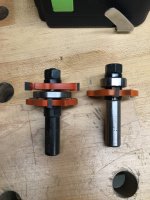Hi Seth.
Sounds like you get it. The boards have been ripped on a band mill to 11". They are not perfectly straight so a TS would take care of that. Then the 2200 for TG.
I haven't bought the tools discussed yet so wanting the best problem solved approach.
The thing that has been my concern is keeping repeatable finished widths. Once the sides have been straitened and one side routed what is the best approach for setting up the track for the other side for accurate widths?
Will I be using a tape measure to set the track? I could have a machine shop make something to attach to the track that set it to the same distance away from the first finished edge. Do you know a better way or is there something festool makes for this
Sounds like you get it. The boards have been ripped on a band mill to 11". They are not perfectly straight so a TS would take care of that. Then the 2200 for TG.
I haven't bought the tools discussed yet so wanting the best problem solved approach.
The thing that has been my concern is keeping repeatable finished widths. Once the sides have been straitened and one side routed what is the best approach for setting up the track for the other side for accurate widths?
Will I be using a tape measure to set the track? I could have a machine shop make something to attach to the track that set it to the same distance away from the first finished edge. Do you know a better way or is there something festool makes for this

